High above St. Lawrence River, on a hot sunny day in August, 1907, workers were working on the Quebec bridge when suddenly, the sound of twisting metals pierced the air, and the giant cantilever bridge under construction failed, crashing into the river with enormous force, such that people miles away in Quebec City believed an earthquake had hit.
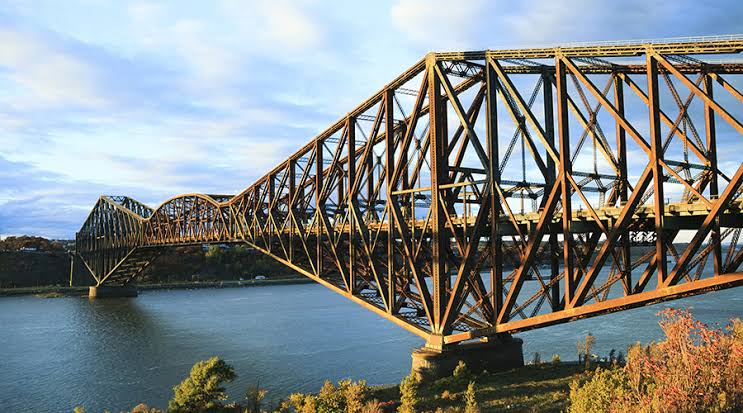
The Quebec bridge was one of the most ambitious engineering projects constructed under the guidance of the worlds most celebrated bridge engineers of the 19th century2. However, its completion didn’t come without a cost – a whopping $23million dollars and two catastrophic collapses resulting in the death of 88 people: the first failure occurring in 1907 causing the death of 75 people and the second failure in 1916 resulting in 13 more fatalities. The aftermath of this collapse was a period of intense learning in code formulation and engineering ethics. This period would see the formation of the American Institute of Steel Construction and the American Association of State Highway Officials amongst others1. It would also give rise to the tradition of all graduate engineers from Canada wearing a ring on the pinkie finger as a reminder that, the fundamental duty of an engineer is always to prevent failure1.
In this article, we’ll explore the Quebec bridge, the circumstances that led to its collapse, we’ll then discuss the factors that contributed to the collapses and the lessons learnt.
The Quebec Bridge
Prior to the construction of the Quebec bridge, the only mode of transportation between the shores of the St. Lawrence River was through a ferry or the use of a winter-time ice bridge. The technical challenge involved with putting a bridge on the river was enormous. Enormous, because even at its narrowest point, it was 3.2km wide and up to 58m deep. Even more complicating was the fact that the river was fast moving (as fast as 14km/hr), had a tidal range of 5m and during winter, ice become stuck in the channel and would pile up to a height of 15m.
In late 1880s interest to bridge the shores of the river gained grew, this culminated in the formation of the Quebec Bridge Company. The company’s role was to plan and deliver the bridge. Edward A. Hoare was appointed as the chief engineer for the company. Hoare had never worked on a bridge of this magnitude; in fact, he had never worked on a cantilever bridge structure longer than 90metres 4. Hence at an ASCE meeting, Hoare met the chief engineer of the Phoenix Bridge Company. Phoenix offered to complete the initial design of the bridge for no fee, provided it was assured of the contract for the final design and construction.
Hoare would also consult with the famous American bridge engineer, Theodore Cooper at the same ASCE meeting, where Cooper would select Phoenix’s proposal as the controversially acclaimed “best and cheapest” solution and would also agree to offer his services as a consultant on the project. Thereafter, Cooper would emerge as the chief consultant for the project, overseeing all technical aspects.
Before we go any further, it’s important to understand that, Cooper’s reputation as a bridge engineer was immense. He was an inspector during the construction of the Eads Bridge at St Louis, which pioneered the use of steel in major bridges, he was assistant general manager of the Keystone Bridge Company before setting up his own consulting practice in New York. In addition to his practical expertise and experience, he had made a significant academic contribution to bridge design. He was the pioneer of a methodology for dealing with railway loads on bridges, he had many technical papers promoting the use of steel as a bridge material to his credit. At approx. 60 years of age, it is only a natural human characteristic, that Cooper felt the Quebec Bridge project would be the crowning achievement of his career2.
Over the course of the project, there would be an interesting facet of Cooper’s engagement. For example, despite the fact that he would be located 800km away from the site, in the city of New York, he accepted the role of inspecting the steel fabrication and erection of the steel bridge. Due to ill health, Cooper didn’t actually visit the, he did however hire Norman McLure as his onsite inspector, relying on the inexperienced McLure as his eyes and ears, a decision that would have far reaching consequences.
Constructing the Bridge
Construction of the bridge superstructure kicked off in mid-1905, the following year, the southern half of the structure was already taking shape when a technical issue suddenly appeared (Figure 2). The steel member arriving on site were heavier than estimated. Perhaps, more troubling was the fact that, the initial design upon which preliminary hand calculations were based considered a central span of 488. However, after the tender procedure, Cooper increased this to 549m citing technical reasons. Although the technical reasons were sound, for example, increasing the central span meant that the piers were located closer to the shore and at a relatively shallower depth, but the reality of the situation was that Phoenix had carried out self-weight calculations for the final design based on the initial 488m span and did not update the self-weight calculation for the revised length. The actual bridge weighed 325MN, as opposed to the initial calculated weight of 276MN, an increase of 18%1. Cooper would assess that the calculation error increased the stresses in the bridge by 7%, yet he concluded that the design was adequate and construction could proceed1.
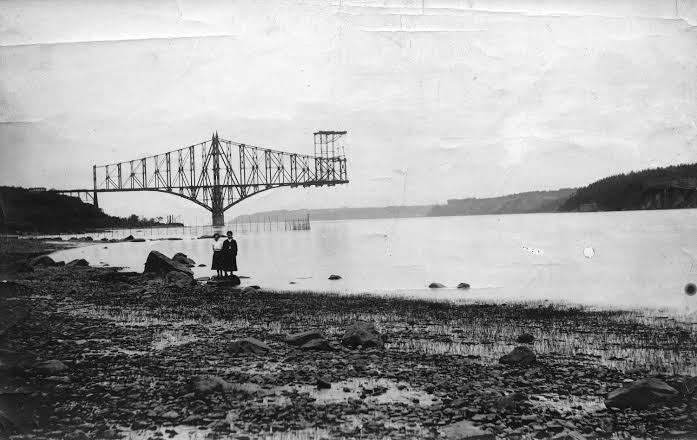
However, signs that the design might not be adequate started to show itself in mid-1907 when McLure, Cooper’s onsite inspector, noticed that a number of the bridge compression members had mid-point deflections. The deflection was more pronounced on the members carrying the largest compressive forces and would grow in multiples as the month go by. McLure notified Cooper and Phoenix’s chief engineer. Phoenix was of the opinion that, the bowings from deflections were pre-existing and present from the steel fabrication shop, expressly implying that the bowing were unrelated to stresses from loading. McLure, however, was convinced that the bowings were not present at the instance of the fabrication, but after installation. Cooper himself agreed that the bowing might’ve actually being an error from the fabrication shop, but believed any error at all would best be from construction procedures, the thought of some members being overstressed never crossed his mind.
The Collapse
By August of the same year, deflections in critical compression members have become great, so great that no one was in doubt of an existing issue with the design. With the southern arm of the bridge already suspended 223m above the St. Lawrence River, the scene was set for catastrophe. On August 27, McLure wrote a letter to Cooper telling him that construction should be suspended until the issue was resolved and went to New York to meet him 2 days after. Cooper agreed that the issue was serious and promptly telegraphed Phoenix to add no load to the bridge until the issue was resolved 4 .
Add no more load to the bridge till after consideration of the facts
Theodore Cooper
However, Cooper message to cease construction arrived Quebec late. At 5:30 pm, just as the timekeeper was about blowing the whistle that brought all work for the day to a halt, one of the critical compression members buckled, initiating the progressive collapse of the entire southern arm and part of the central section into the St. Lawrence River. The collapse took only 15 seconds and the sound of the wreckage was heard as far as 10km away from the site. Of the 86 workers on the bridge that day, only 11 would survive, and with mild to severe injuries (Figure 3).
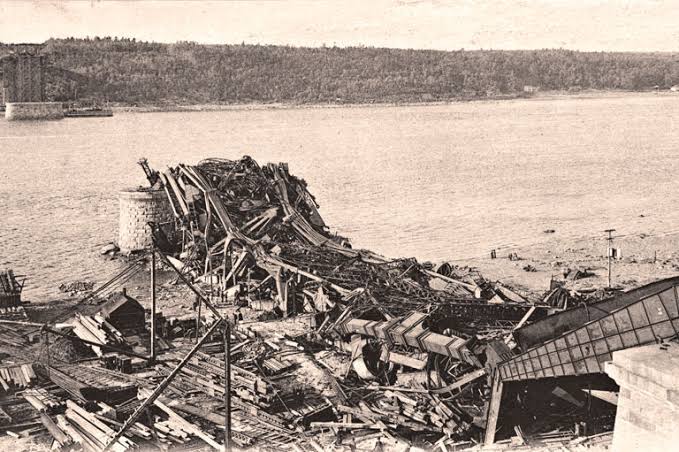
Investigation into Cause of Collapse
What followed was a Royal Commission of inquiry to determine the cause of collapse, the next day. The commissioners would conclude that, the failure was neither related to detailing, fabrication or material quality but due to bad design3. The commission would find that, it was indeed the buckling of one of the most critical compression members that initiated the collapse. The commissioners presented a full report on Feb 1908 and would attribute responsibility for the disaster to two men, consulting engineer Theodore Cooper and P.L. Szlapka, Chief Designing Engineer for the Phoenix Bridge Company 3.
The conclusions of the report submitted by the commissioners is as follows:
- The failure cannot be attributed directly to any cause other than errors in judgement on the part of the two design engineers 3.
- The design of the chords that failed were prepared by Phoenix Chief Design Engineer, P.L Szlapka 3.
- The design was examined and officially approved by Theodore Cooper, consulting engineer of the Quebec Bridge and Railway Company 3.
- The failure of the Quebec Bridge Company to hire an experienced bridge engineer to the position of chief engineer resulted in a loose and inefficient supervision of all parts of the work 3.
Lessons from Failure
The failure of the Quebec bridge teaches us on the risks of innovative projects and the dangers of relying on the judgment of just one individual. We’ll dissect this from two distinct perspective: The technical lessons and the human/ethical lessons.
Technical Lessons
The self-weight miscalculation played the biggest role, and should have been sufficient to condemn the bridge design from the outset. What makes Cooper’s decision to continue after the error came to light quite extraordinary was that the working stresses adopted for the bridge’s design were already very high — in fact, considerably higher than the norm at the time of construction4. Cooper allowed stresses 9% higher relative to the modern AISC allowable stresses2. Cooper wasn’t just utilizing higher stresses than AISC, he was doing so from 100years earlier. Notwithstanding the fact that steel was a relatively new bridge material and little to nothing was known about the behaviour of latticed compression members at the time.
More contentious was that, when concerns were raised regarding the high stresses by a bridge engineer from the Department of Railways and Canals, they were swiftly dismissed by Cooper1. Despite Cooper’s willingness to accept unrealistic high stresses with no theoretical guidance and practical precedent in the design of such members, no member testing was undertaken. The reputation of Cooper as a renowned bridge engineer ensured that his views were always upheld.
Certainly, obtaining funding for testing was an issue; indeed, funding plagued every aspect of the project; every conflict between safety and economy was always resolved in favour of economy1. However, when the Phoenix Company did secure funding, Cooper turned down the offer citing “time constraints”. Following the failure testing was undertaken and one-third of the copies of the lattice steel members exploded under loading confirming the commission ‘s view of bad design all along. It is a sad reality that funding that is almost always not available for testing is always available after failure.
Human/Ethical Lessons
Perhaps, the biggest cause of this failure is a natural human tendency; a conflict between ego and engineering ethics. Ego, itself is not a horrible human trait to have. It drives our hunger to optimize ourselves, realize our full potential and strive to always create the best, but to the extent that every conflict between ego and ethics is always resolved in favour of ethics.
Given that the Quebec Bridge was to be the crowning achievement of Cooper’s career, why will an experienced engineer like Cooper adopt an approach of increasing stresses beyond normal and refuse member testing? Was his ego as a renowned bridge engineer driving him beyond the boundaries of his engineering knowledge and practice? Well, turns out that ego played a role, and one can only explain this by trying to understand Cooper’s state of mind as he approached the Quebec Bridge project.
In the wake of the completion of the Forth Bridge, far away in Scotland in 1890, many would irk at the level of conservatism in the design – it was after all designed in the aftermath of the Tay Bridge failure and there was no appetite for another bridge disaster 4. Cooper in his usual element was contemptuous in his comment. He described the bridge as the clumsiest structure ever designed by man; the most awkward piece of engineering and that an American would have done it for half the cost.
While, any examination of this view, as the basis of Cooper’s approach to the Quebec Bridge would be speculative, there’s enough evidence to suggest that Cooper comment played a role, beyond being speculative. The Forth bridge span of 521m was longer than the 488m initially proposed by Phoenix for the Quebec Bridge. Cooper would extend this to 549m, making it the longest cantilever bridge in the world. While there were good technical reasons for this change as discussed in the preceding section, this decision contributed to the miscalculation of the self-weight.
Furthermore, and probably the most consequential of all was Cooper’s view that the Forth Bridge was clumsy and awkward and that it could’ve being built for half the cost. This attitude appears to have influenced his decision to increase working stresses beyond normal, thus reducing the cross-sectional areas of the bridge members. Recall that, in the light of the increase in the central span from 488 to 549m, Cooper still agreed to carry on with construction. It was indeed during the design of the replacement bridge that Cooper’s drive for slender members became stark. We know that, any design in the wake of a collapse would be very conservative. But in the case of the Quebec Bridge, the increase in the cross-sectional area of members went through the roof, increasing by as much as 150%. The weight of the replacement bridge was 2.5 times heavier. The irony was that, the replacement bridge did not look any different from the “clumsy” Forth Bridge (Figure 1 & 4)- the very thing Cooper had hoped to avoid.
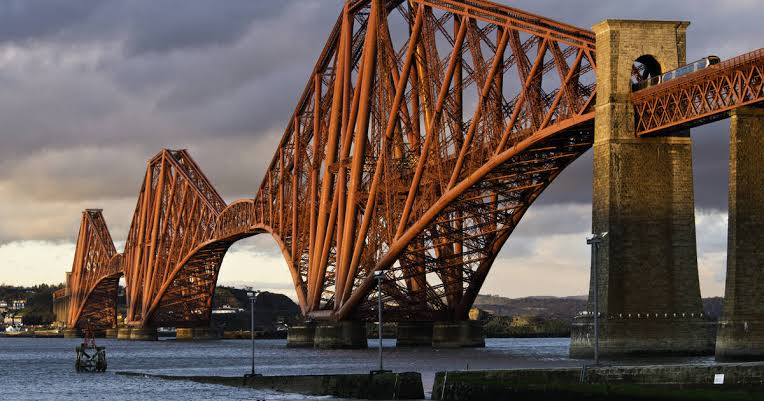
All in all, Cooper’s reputation far from making the project safer contributed to placing it at risk. Cooper’s insistence on increasing the span and utilizing a higher working stresses appeared to have been guided by concerns of legacy rather than a sound engineering practice. In fact, at the very beginning of the project when Cooper was told that his work will be subjected to a peer review, he strongly objected and claimed that “this put me in the position of a subordinate, which I cannot accept”. This refusal to submit to independent checks coupled with the ‘unquestioning environment’ his reputation created resulted in his decisions going unchallenged. Cooper’s very presence created a false feeling of security.
Finally, this failure brings to bare other human factors, which we’ve always seen with engineering failures – professional negligence. The biggest irony, which this writer finds most titillating was the fact that Cooper located 800km away would accept total responsibility for a project of this magnitude. Phoenix Bridge Company located 900km away in the city of Pennsylvania would also agree to design and supervise it. While neither Cooper nor Phoenix design engineers would visit the site even for once, throughout the construction of the superstructure.
Although the project team looked good on paper, the reality was that the experience required for constructing a bridge of this size was just not there. This was not limited to McLure alone. Hoare had not worked on a bridge longer than 90m and the Phoenix Bridge Company was relatively inexperienced for a bridge of this scale. It had even experienced a number of collapses during construction on previous projects. In the commission comments, “It was clear on that day, that the greatest bridge in the world was being built without a single man within reach, who by experience, knowledge and ability was competent to deal with the crisis”3.
And, of course, the story of the Quebec Bridge doesn’t end here, in 1916 during the construction of the replacement bridge under the guidance of one of the engineers on the Forth Bridge, in an operation to install one of the “clumsy” central spans, a lift bearing failed and the 4500t steel central span collapsed into the river, resulting in 13 more deaths (Figure 5).
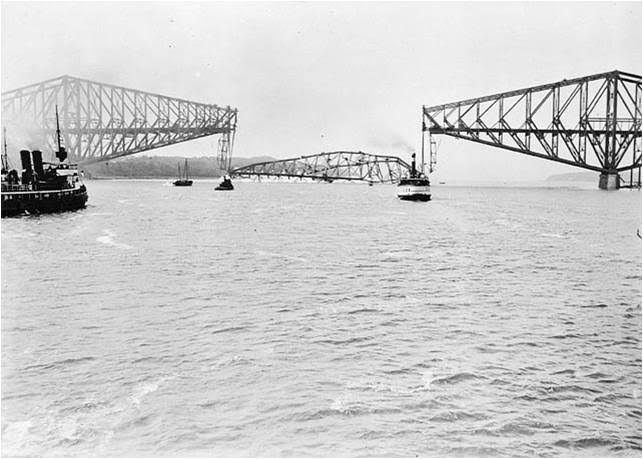
In August 1919, the bridge was completed and construction came to a halt, at a total cost of $23million and the lives of 88 bridge workers. The Quebec Bridge is still the longest cantilever bridge in the world and now accommodates three highway lanes, one rail line and a pedestrian walkway.
Also See: The Citicorp Centre Tower: Almost a Tragedy
Sources & Citations
- Quebec Bridge National Historic Site of Canada, Canadian Register of Historic Places. (Retrieved Dec, 2021)
- Middleton W. D. (2001) The Bridge at Quebec, Bloomington, USA: Indiana University Press3) Å kesson B. (2008) Understanding bridge.
- Royal Commission Quebec Bridge Inquiry Report. Ottawa: SE Dawson, by order of Parliament 1908. (Retrieved Dec, 2021)
- Brady S. (2014) The Quebec Bridge Collapse: a preventable failure (part 1 & 2). The Institution of Structural Engineers Professional Guidance Note.
Thank You!
